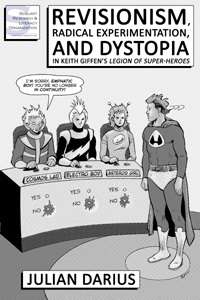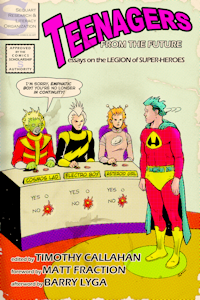Published in late 1988 as a three-issue monthly crossover mini-series, the central premise of Invasion (titled Invasion!, with an exclamation mark, on the cover) was simple: aliens invade the Earth.
The series was plotted by Keith Giffen, by then at the end of his second year on what had become Justice League International. Bill Mantlo, in his first work for DC after a long career at Marvel, scripted over Giffen’s plots. The mini-series had a large number of artists, including Giffen himself, Todd McFarlane, Bart Sears, and P. Craig Russell.
Alien invasion stories are nothing new to super-hero comics. Usually, those stories have a limited scope, and it’s more common for a super-hero to discover and prevent an invasion than for one to actually occur. But even when the scope was larger, these stories had previously been contained to a single series of set of characters.
Of course, this didn’t make a whole lot of sense, given that their universe was shared by many other super-heroes, with their own series. Even when an alien invasion was only threatened, one would think a super-hero wouldn’t want to handle something so potentially world-changing by himself. When an actual invasion occurred, even if it was only a single ship, one would think that other super-heroes would respond to it, or at least react to what must have been a huge news story around the globe.
Because of this, an alien invasion was a perfect subject for a universe-wide crossover. Invasion was only DC’s fourth such crossover. In the wake of Crisis on Infinite Earths, the company began offering about one crossover mini-series a year. In addition to spurring sales, these crossovers helped solidify continuity between DC’s titles, building a feeling of a shared universe that had been comparatively lacking before Crisis on Infinite Earths. And there was perhaps no better vehicle through which to do this than a full-scale alien invasion, which would affect the entire planet, forcing heroes to coordinate and to respond around the world.
Invasion used this opportunity to fix another problem of that earlier era, in which alien threats appeared in multiple, disconnected titles: those aliens were all unrelated. Thus, a super-hero could encounter an extraterrestrial species said to be known throughout the galaxy – yet which hadn’t been seen or mentioned before. There was simply no consistency. Accentuating this, DC’s Legion of Super-Heroes, set 1000 years in the future, had developed its own set of what seemed to represent the dominant extraterrestrial species in the galaxy. These species hadn’t developed spaceflight within the last 1000 years, yet largely hadn’t been seen in the present-day DC Universe.
Invasion rectified this and featured nearly every active DC character (and some inactive ones!) related to outer space, thereby creating a unified cosmos for the DC Universe for the first time. This represented a major step towards the coherent single universe promised by Crisis on Infinite Earths.
To a lesser extent, Invasion also addressed another problem left over from earlier years. It’s not surprising that American super-hero comics would be disproportionately set in the United States. This sometimes left the impression, however, that only Americans got bitten by radioactive spiders and all alien spaceships bearing baby Kryptonians happened to land on U.S. soil. With super-hero comics (in the wake of revisionism) taking themselves more seriously, and DC trying to build a more logical and coherent universe for itself, the company sought to better represent the entire planet in its stories, not simply the United States. Keith Giffen had already done this, to some extent, in his Justice League International (as had DC’s previous crossover, Millennium). Although Invasion didn’t introduce many new foreign characters, its global scale featured many that already existed, solidifying them much as it did DC’s extraterrestrial species. The mini-series also featured many locations which either hadn’t been seen before or hadn’t felt distinct. Invasion wasn’t the end of this journey (which really continues to this day, much like DC’s continuing attempts to diversify its characters), but the crossover did mark a major milestone along the way.
But the most obvious way that Invasion changed the DC Universe was revealed in the opening pages of the first issue, which fundamentally changed the way super-heroes worked in the DC Universe. Those pages established that some humans in the DC Universe had something called a “metagene” which could activate when triggered by extreme stress, giving those humans unpredictable super-powers. Of course, this didn’t apply to extraterrestrials such as Superman, nor to characters who got their powers from technology (like Green Lantern), nor to most characters with magical origins (like Wonder Woman). But it still applied to the vast majority of DC’s characters, essentially rewriting their origins.
As an explanation for a super-hero universe, the metagene concept was admittedly simplistic. But as quasi-scientific as this was, it was a major step in the right direction. Super-hero comics had long featured improbable origins, such as being exposed to chemicals or radiation, which seemed to forever remain undiscovered by the larger world as an easy way to obtain super-powers. Now, these origins were given a genetic twist, which went a long way towards explaining why certain characters gained super-powers under these situations, which we know either don’t work this way or would kill instead.
Although simplistic, the metagene concept isn’t outside the realm of respectable science fiction. To say that the DC Universe strained credulity would be an understatement. Its history combined elements as disparate as Atlantis, time travel, magic, and plenty of extraterrestrials who happened to land on Earth. At least with the metagene, the majority of DC’s super-heroes existed because of one single difference between their world and our own. No longer did readers have to accept a thousand different origin stories, each of which strained the laws of physics, not to mention biology. Instead, a single difference separated our world from the DC Universe: the presence of the metagene. Magic and futuristic technology would remain, but those could be justified as things we haven’t discovered yet. In a single gesture, the DC Universe became a decidedly more realistic and intelligible place.
In essence, the metagene explanation was a variation on the idea behind Marvel’s X-Men, which was then one of comics’ most popular titles. Since its first issue, that series had claimed that its characters got their powers through genetic mutation. Initially, this was simply a way for Stan Lee to avoid having to explain how the characters got super-powers; they were simply “mutants.” By the 1980s, however, this explanation had been given its own mythology and deeply woven into the series. However, Marvel’s mutation explanation never claimed that humans in the Marvel Universe were any different than those in real life. And in the real world, mutations might change the color of a frog’s skin (or give it a non-functioning heart) but don’t usually result in the ability to fly and shoot blasts of energy from one’s hands. The metagene concept improved upon from Marvel’s mutation idea: both were rooted in genetics, but the metagene offered an explanation as to how super-powered genetics might necessarily differ from our own. Also, DC applied this concept to its entire universe, not merely a corner of it (as was the case with Marvel’s X-Men).
The metagene concept wasn’t arbitrarily introduced in Invasion; instead, it was wedded to the story as the aliens’ justification for their invasion. Earth’s super-heroes represented a threat, but the real threat was the potential that lay within humanity – which, thanks to the metagene, could generate untold numbers of future superhumans.
In all of this, Invasion may be seen as a revisionist work. The metagene was only the clearest example of this, literally revising the past to make it more logical. This same concern for narrative logic may also be seen in the various ways Invasion attempted to make the DC Universe a more coherent setting, whether in its presentation of extraterrestrial civilizations or of an international world responding to an alien threat.
Like many other revisionist works, Invasion also showed concern for its format. DC’s three previous universe-wide crossover mini-series had consisted of standard issues (although a few issues of Crisis on Infinite Earths were almost twice as long). After the first two mini-series were published monthly, DC tried weekly publication (with Millennium), which had the advantage of giving readers more of the main story than 22-24 pages per month. This had the disadvantage, however, of requiring weekly coordination across DC’s entire line, especially since tie-ins were woven closely into the main mini-series. For Invasion, DC returned to monthly publication, and it made sure that the main mini-series would make sense without reading all of the tie-ins (which hadn’t been the case with Millennium). Invasion also kept the advantage of giving readers the story quickly by making each of its monthly issues 80 pages long. This harkened back to the 80-page giants of DC’s Silver Age – except those were reprints and included advertisements and letter columns in their page count, whereas each issue of Invasion consisted of 80 pages of new material in every issue. Essentially, Invasion constituted a trilogy of short graphic novels, then a relatively innovation in American comics, except that these were printed on normal paper to keep the cover price low and accessible to readers. Each issue even had its own title, printed larger than the word “Invasion,” which helped make the issues feel like a series of subtitled graphic novels.
Invasion doesn’t seem to have too much high-art pretension. It was, after all, an alien invasion story designed to work as a super-hero crossover. But its format could hardly have been more sophisticated. To this day, no subsequent crossover has quite matched it in terms of format and structure.
Each issue read like a graphic novel, telling a complete chapter of the continuing story. The 80-page length gave Giffen room to tease out his story, which didn’t require an artificial cliffhanger every 20-or-so pages. Each issue also had its own identity, setting into motion a different phase of the crossover. Thus, the first issue led into a month of tie-ins labeled “First Strike!” and depicting the global response to the invasion. In the second issue, the invasion was defeated, leading into a month of tie-ins labeled “Aftermath,” in which the characters and the planet struggled in the wake of the alien withdrawal. These tie-ins ended with the detonation of a metagene bomb, which led into the final issue of the mini-series.
This three-act structure made the mini-series read better on its own, but it also provided the overall event with two clear and distinct stages, without either feeling protracted (each was only a single month long). It’s often easy to get lost in a universe-wide crossover event, and there’s a certain appeal to this complexity, even for its own sake. If one’s looking for a streamlined crossover in which readers couldn’t get lost, Invasion’s very much the model to follow.
To be continued.































































